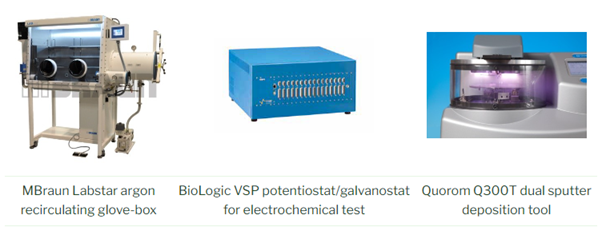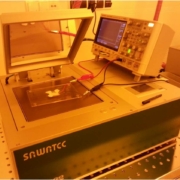Battery Energy Storage
About
Simulation and processing of battery energy storage materials and architectures for integration with energy harvesting solutions. Electrochemical characterisation of energy storage performance including correlation with nanovisualisation through scanning electron microscopy, transmission electron microscopy and atomic force microscopy characterisation.
Description
Assessment of the electrochemical characteristics of as-deposited battery materials and post-processed for optimum performance. Materials characterisation using x-ray diffraction and Raman spectroscopy to establish the likely outputs of the materials. Electrochemical test system to analyse battery characteristics of individual electrodes, electrolytes or full cells for integration in hybrid energy harvesting and storage solutions. Microelectrodes for accelerated testing/sensing of battery materials performance. Interface assessment and nanoengineering to improve kinetics and cycle life.
Simulation models for battery materials assessment of chosen architectures. BioLogic multichannel electrochemical test system which allows simultaneous test of independent cells controlled with a single PC enabling electrochemical analysis of more than one cell in parallel. Impedance spectroscopy of the energy storage materials can also be assessed with this system. Lithium based and oxygen or water sensitive materials can be housed for analysis in the argon environment of the MBraun Labstar glovebox with direct access to the BioLogic test system. A Quorom Q300T dual sputter deposition tool: DC sputtering of prototype anode and cathode materials. Fabrication: 4-inch wafer scale facilities for active material nanoarchitecture fabrication including interdigitated electrode arrays fabricated for analysis of cycling behaviour in well-defined architectures.
Technical specifications:
Battery cells operating with a 100 mA maximum current. Materials processing on 4 inch diameter substrates.
Case study:
An SME or research team are developing new materials for a battery but need access to simulation or characterisation equipment to optimise this. InfraChip can provide access to the facilities required. An SME or research team have developed an energy harvesting solution and require assessment of the integrated energy storage options to facilitate commercialisation of their technology.
Optional:
https://doi.org/10.1002/batt.202300447
https://doi.org/10.3390/ijms241311207
https://doi.org/10.1002/batt.202000236
https://doi.org/10.3390/molecules25246002
https://doi.org/10.1002/open.201900313
https://doi.org/10.1016/j.est.2019.02.002
Access Provider / Facilities






